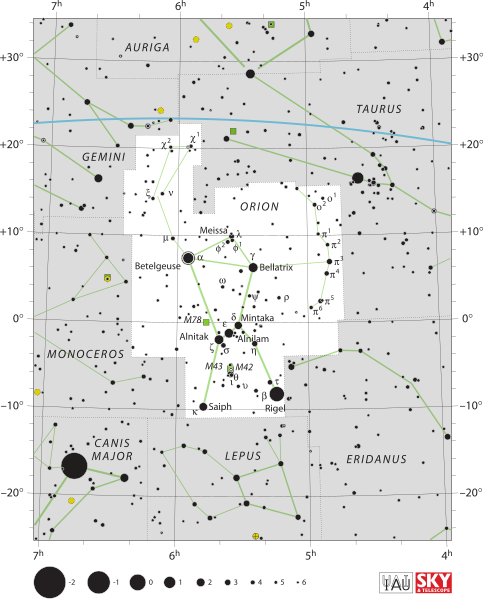
First, we said goodnight to Venus as our sister world sank into the western haze over the school library. Binoculars give a hint that Venus has phases, like the moon, but a good telescope really helps.
Then we used binoculars to see Betelgeuse - a giant red star that forms the top shoulder of Orion. Then we tracked downwards and eastwards to view Sirius and Procyon, his faithful hunting dogs.
On the other side of Orion's belt, pointing upwards and westwards lies the red star Aldebaran, surrounded by an aging open cluster known as the Hyades. Further onwards and westwards we come to the magnificent Pleiades - also known as the seven sisters. These are fairly young stars, all formed in the same cocoon of dust and gas about 100 million years ago. You could think of the Pleiades as a sort of primary school for stars, while the Hyades are more like a secondary school.
We then hooked back to Orion, and found the glorious Great Orion Nebula under the belt - it is sometimes described as Orion's sword. This is an enormous cloud of dust and gas left over from the birth of the galaxy. At some point, shock waves from a nearby supernova explosion triggered the formation of thousands of stars in the cloud, so it can be thought of as a nursery for stars.
So there you have it - stellar birth to stellar old age in just a few hops around Orion. If we'd been able to see the Crab Nebula in Taurus (not far from Aldebaran either), we'd have also seen what happens to stars after they die.
After this, as clouds gathered above we had a look at Jupiter, catching a nice view with two moons on either side, and the two major cloud belts showing nicely.
Once viewing had finished, it was great fun showing off the transit instrument, and explaining (probably very badly) how the "lines of longitude" on the sky (right ascension), can be used as a clock to create a measure known as sidereal time. The apparent movement of the sky is something absolutely central to really getting inside stargazing. Once you have a feel for what to expect, in what direction and when (and this is not that hard to do), it makes a real difference to your confidence in finding your way around. I very highly recommend taking the time to get familiar with ideas on the topic of the celestial sphere.
Finally, we spoke briefly about binoculars. May I recommend that you think about getting yourself a well-made pair of something like 8x50? These are quite easily bought second-hand for very little, and they make a world of difference to anyone starting out on learning about the night sky. I've added a link to the firm Telescope House. They supplied our new telescope, and have always been very helpful whenever I have been in touch - if you feel like buying new, they are worth calling for some honest advice about matching budget with performance.

